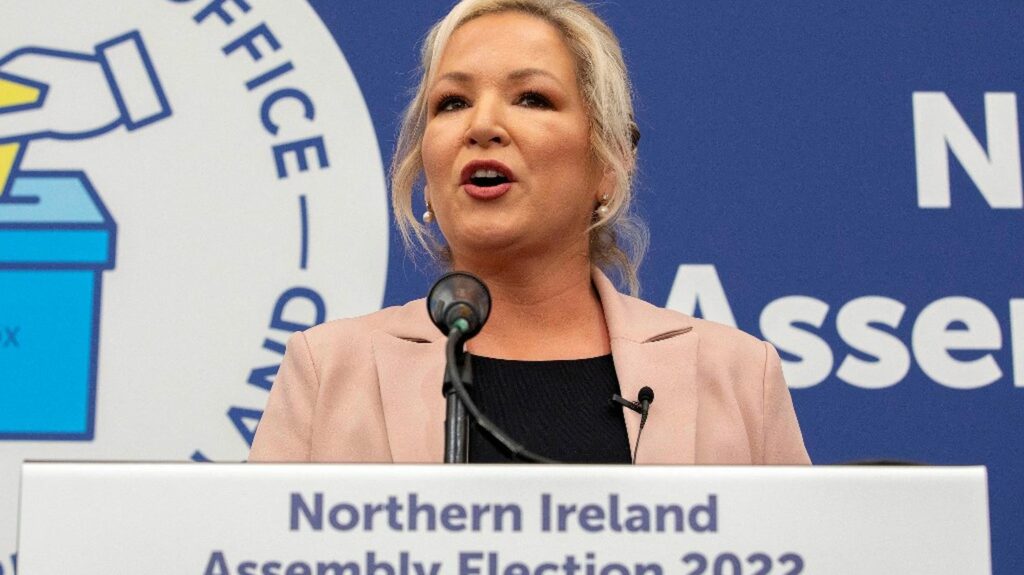The polls were right. The nationalist party Sinn Fein, supporter of a reunification of Ireland, won a historic victory, Saturday, May 7 in Northern Ireland, during the legislative elections.
After a long count, Sinn Fein won 27 seats in the local Assembly of Stormont, where the 90 elected were renewed in a ballot held on Thursday, against 25 for its unionist rival DUP, loyal to the British crown. . The other big winner is the centrist Alliance party, which is making strong progress, with 17 seats.
In what context does this historic turning point take place? What will happen now? Does this electoral success pave the way for the reunification of Ireland? Response elements.
1In what context does this victory take place?
As a reminder, Ireland has been divided in two since 1921 and the War of Independence. The partition between the North, attached to the United Kingdom, and the South – which forms the Republic of Ireland – led to three decades of bloody unrest (between the end of the 1960s and the end of the 1990s) between nationalists (Catholics ), supporters of reunification, and unionists and loyalists (Protestants), defenders of the attachment of Northern Ireland to the British crown. The Good Friday Agreement in 1998 put an end to this civil war which caused the death of 3,500 people. Since then, the government of Northern Ireland has to be run jointly by nationalists and unionists.
Brexit has disrupted this fragile balance. In April 2021, then last February, the Unionist Prime Ministers of Northern Ireland, Arlene Foster and Paul Givan, unhappy with the post-Brexit situation, successively resigned, again leading to a paralysis of the local executive (the province Britain had already been without a government or parliament between 2017 and 2020).
The reestablishment of customs controls in Northern Irish ports, as if the border between the European Union and the United Kingdom were located in the Irish Sea, is rejected by the Unionists, opposed to a measure which symbolically puts them on the sidelines. distance from their mother country.
2How did Sinn Fein fare?
Historically, Sinn Fein is the former political showcase of the paramilitary group Irish Republican Army (IRA). How did he manage to forget this label? With power sharing, « he has succeeded in establishing himself as a credible political force » and campaigned not on reunification but on « social and economic themes » more carriers within the electorate, explains on RFI Agnès Maillot, professor at the University of Dublin (Dublin City University).
This shift was made possible in particular by the personality of Michelle O’Neill, former First Deputy Minister of Northern Ireland and Vice-President of Sinn Fein, who should inherit the post of Prime Minister. As written Releaseshe’s there « first leader of the party (…) to have had no direct link with the IRA: she was barely of age when the war ended ».
The party also benefited from the decline of the unionist DUP party, the big loser of Brexit. After forcing Theresa May not to accept any « deal » which would induce differential treatment of Northern Ireland compared to the rest of the United Kingdom, he saw Boris Johnson send all his promises to shreds once elected. « Rolled in Flour »the DUP lost in « credibility » and was sanctioned at the polls, losing « voters on his right and on his left »analysis on RFI Christophe Gillissen, professor of British and Irish civilization at the University of Caen Normandy.
3What will happen now?
Michelle O’Neill promised to overcome divisions. “I will provide inclusive leadership that celebrates diversity, that guarantees rights and equality for those who have been excluded, discriminated against or ignored in the past”she said, saluting « a very important moment of change » with entry into « a new era ».
But the talks for the formation of a government promise to be difficult and the risk of paralysis hovers, the Unionists – who return to the post of Deputy Prime Minister – refusing to join a government as long as post- Brexit. DUP heavyweight Edwin Poots has warned negotiations will take “hopefully weeks, or even months”.
London, like Dublin, has called on nationalists and unionists to unite in a local executive to ensure the « stability » of the British Province.
4Do these results pave the way for reunification?
Although Sinn Fein has not campaigned on the issue, party leader Mary Lou McDonald said on Friday she believed a referendum on Irish reunification could be held within the next five years. . On this point, specialists are cautious. It is the British minister in charge of the province, Brandon Lewis, who must technically launch the referendum process. « He will only do it if he feels there is a majorityobserves for franceinfo Fabrice Mourlon, professor at the Sorbonne Nouvelle. However, according to the latest polls, around 30% of Northern Irish people are in favor of reunification.
« Reunification may happen one day, but probably much more naturally than if the parties make it a subject. »
Fabrice Mourlon, professor at the Sorbonne Nouvelleat franceinfo
The researcher notes the emergence of the centrist Alliance party in these elections: « He doesn’t play on the denominational side, the Northern Irish are tired of not having institutions. » “We are no longer in a binary situation”, abounds on RFI Agnès Maillot. Believing that Sinn Fein has achieved « a glass ceiling » with its 27 seats, it highlights the progress of a population « which claims neither unionism nor nationalism and which is content with the current situation. The voters want an autonomous local government which functions and manages daily life » on housing, economic and environmental issues.

